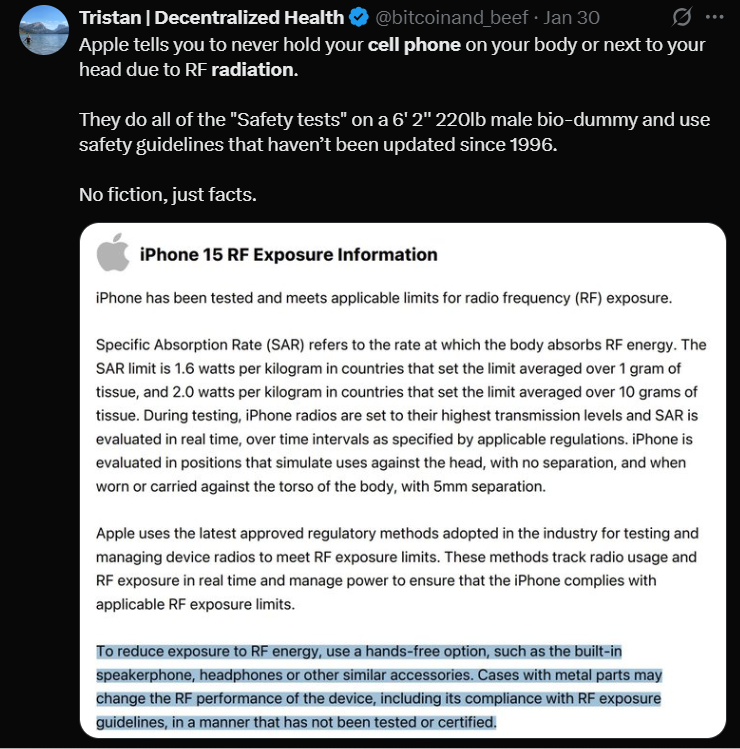Every iPhone comes with a small print disclaimer tucked away in its user guide, often overlooked by the millions who rely daily on these devices. Apple explicitly advises against carrying your phone directly against your head or body due to radiofrequency (RF) radiation. Yet, despite this clear warning, most consumers remain unaware of what this truly implies about their safety—and why current FCC safety standards are fundamentally inadequate.

The Hidden Reality of Apple’s RF Warnings
Apple’s RF exposure guidelines, found deep in their product literature, reveal a crucial yet rarely discussed truth: holding your phone too close can expose you to potentially unsafe levels of radiation. Specifically, Apple’s compliance testing is based on an outdated standard developed in 1996, designed around a thermal-only model—that is, it only measures harm if the radiation heats your tissues. This standard was created using a test subject resembling a 6-foot-2-inch, 220-pound adult male mannequin, hardly representative of the diverse population—including children, adolescents, and pregnant individuals—who regularly use these devices.
The Misleading Thermal-Only Safety Model
The problem lies in the very basis of these so-called “safety” limits. The FCC’s guidelines, which Apple references, assume harm from radiation occurs only through heating of tissues—a concept deeply rooted in outdated science. Modern biological research, however, overwhelmingly demonstrates that harmful effects of RF radiation occur well below thermal thresholds, affecting fundamental biological processes like cellular signaling, oxidative stress management, and even genetic integrity.
For example, the National Toxicology Program (NTP) found that radiofrequency exposure at levels considered “safe” by FCC standards led to significant biological effects, including increased cancer risk and DNA damage. This groundbreaking research conclusively showed that lower RF doses sometimes cause more harm than higher doses—a nonlinear response entirely ignored by current safety guidelines.
Apple’s RF Testing: The 220lb Male Dummy Problem
What’s even more troubling is how these outdated standards are applied. Apple tests their phones on a plastic mannequin equivalent to a 220-pound adult male. This standardized dummy completely fails to represent the vulnerability of real-world users—especially women, children, and adolescents, whose bodies absorb RF radiation far differently than an adult-sized model.
The implications are serious:
- Children are exposed at disproportionately higher risk, as their developing tissues are more sensitive to electromagnetic fields.
- Pregnant women and their unborn babies are particularly vulnerable, as radiation affects critical developmental processes that can have lasting impacts.
- Individuals who fall below the size and weight of Apple’s test dummy are likely exposed to radiation levels significantly exceeding the tested “safe” thresholds.
This flawed approach to testing creates a dangerous illusion of safety, making consumers assume their devices pose minimal risk, even as evidence mounts linking RF exposure to serious health conditions.
The Real Risks You Should Know About
Recent studies, including those from the National Toxicology Program, underscore that RF exposure can cause severe health impacts, including:
- Cancer: Increased rates of brain and nerve tumors (gliomas, schwannomas) have been documented.
- Reproductive harm: Studies consistently link RF exposure to reduced sperm quality, hormonal disruption, and increased miscarriage rates.
- Neurodevelopmental disorders: Increasing prevalence of ADHD, autism, and cognitive impairments coincide with widespread wireless technology exposure.
Moreover, contrary to assumptions, these effects are not always proportional to the radiation dose or exposure duration. Short bursts of intermittent radiation exposure—typical of modern phone usage—can be more harmful than continuous exposure because the body’s cells are repeatedly stressed without sufficient recovery time.
Why This Matters—And Why Apple’s Disclaimer Isn’t Enough
Apple telling you to keep your phone away from your body is essentially an admission that current testing standards cannot guarantee safety. Yet, very few users ever see this warning, and fewer understand its significance.
Because of Section 704 of the Telecommunications Act of 1996, local governments are barred from rejecting the installation of RF-emitting infrastructure based on health concerns. This effectively removes the power from communities to protect themselves, leaving citizens exposed and vulnerable.
It’s Time to Demand Better
We can’t rely on disclaimers hidden in manuals to protect public health. Real safety will only be achieved by:
- Updating FCC guidelines based on modern, biologically accurate science—not just outdated thermal effects.
- Restoring independent scientific research as mandated by Public Law 90-602.
- Repealing Section 704 to restore local control over the placement of wireless infrastructure.
- Promoting safer technologies like Li-Fi (light-based wireless communication), fiber optics, and space-based broadband, significantly reducing exposure without compromising connectivity.
Final Thoughts
It’s clear: the old thermal paradigm doesn’t cut it anymore. RF radiation affects your body in complex, nonlinear ways that current guidelines simply don’t address. Apple’s quiet disclaimer isn’t just a legal footnote—it’s an urgent signal that our approach to wireless safety is dangerously flawed.
It’s time for real transparency, modern standards, and a commitment to protecting human health, not just industry interests.
The next time you pick up your iPhone, remember this hidden warning and join the push for change—your health might depend on it.